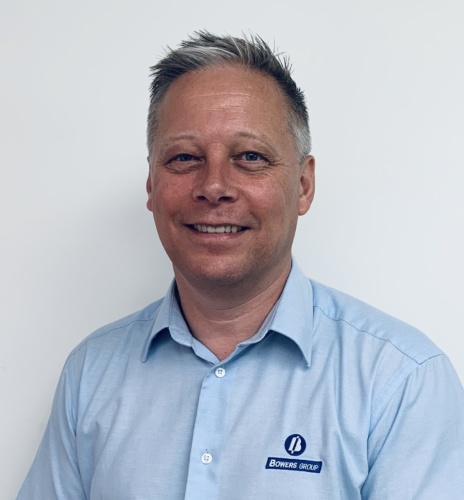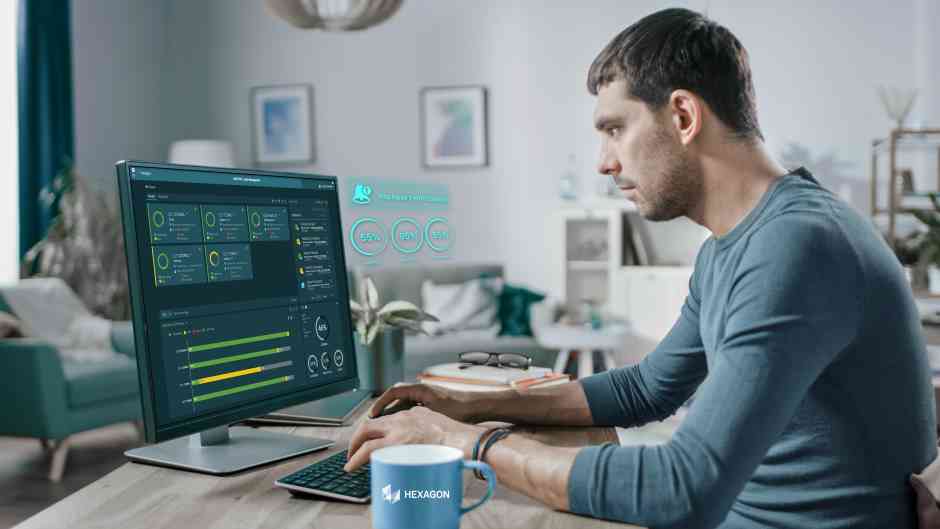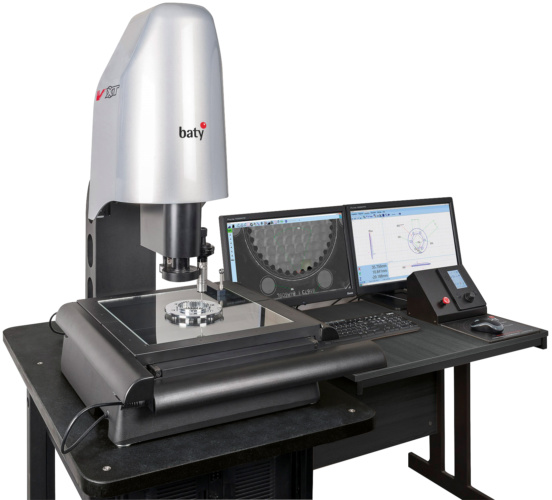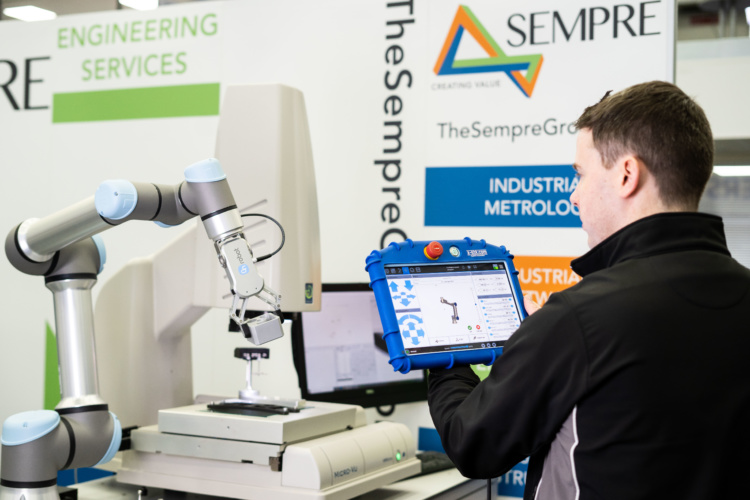Smart, connected and easy to use metrology solutions are a key component of any advanced manufacturing operation but how can engineering firms ensure that they’re tapping into the full capabilities of the technology? The Engineer approached experts from some of the leading organisations in this sector – Bowers Group; Sempre, and Hexagon Manufacturing Intelligence - to learn more about the trends and technologies that are driving developments in the field.
Meet the panel
- Geoff Jackson - Business and Product Development Director, Baty International (part of the Bowers Group)
- Mike John - Managing Director, The Sempre Group
- Nicolas Lachaud-Bandres - Integration & Automation Business Development Manager, Hexagon Manufacturing Intelligence
What trends are driving developments in metrology?
 Geoff Jackson: De-skilling the measurement process and, where possible, removing operator influence has always been a driver to improved process capability but I’m now seeing a clear desire to migrate away from attribute based gauging.
Geoff Jackson: De-skilling the measurement process and, where possible, removing operator influence has always been a driver to improved process capability but I’m now seeing a clear desire to migrate away from attribute based gauging.
More than ever, our customers want to report and analyse variable measurement data. We have therefore added significant reporting functionality allowing the user to customise how and where data is reported for any given component. Wireless data acquisition and closed loop process control is also on customers’ wish lists so the ability to export data as well as report locally is paramount.
 Mike John: Manufacturers are looking very hard at the way they manage the quality process, from drawing review and acceptable quality limit (AQL) qualification right through to demonstration of compliance.
Mike John: Manufacturers are looking very hard at the way they manage the quality process, from drawing review and acceptable quality limit (AQL) qualification right through to demonstration of compliance.
Businesses are realising that the management of the whole metrology process can be disparate, manual and time consuming. These overhead costs tend to get absorbed but now it is being recognised that this is an area that can produce tangible cost reductions and increases in productivity and efficiency.
Manufacturers are looking to automation to help improve their processes — simplifying robotic and software integration is allowing more businesses to embrace this type of technology.
 Nicolas Lachaud-Bandres : Our customers have real trouble hiring skilled metrology professionals – we did a global survey of our customers and 73% had difficulty hiring.
Nicolas Lachaud-Bandres : Our customers have real trouble hiring skilled metrology professionals – we did a global survey of our customers and 73% had difficulty hiring.
When I visit customers, I see highly skilled quality experts loading components onto a CMM. They are tied to that machine, and so is their expertise. We clearly need to make it easier for quality professionals to supervise multiple metrology devices and focus their expertise on improving the product quality and manufacturing processes.
Metrology departments are betting on automation and remote supervision, but it can take months to integrate the systems and connect existing CMMs into these workflows. How you would you feel if it would take two hours to pair your mobile phone with your car?
How are your products are helping customers meet the challenges that they are facing?
GJ: Our products need to have the right measurement and accuracy capability, but it’s how all of that powerful functionality is presented to the user that determines whether any capable measuring system is being used to its full potential.
Feedback tells us that ease of use and the lack of need for intensive training lead to a greater ‘buy in’ from staff and a higher number of capable users, thus providing more options when times are busy. Very often, components traditionally require measurements to be performed from a number of instruments to complete the final inspection. The combination of camera and touch trigger measurements in the same automated inspection often serves to remove the ‘bottleneck’ from the traditional CMM and improve work flow through to dispatch.
MJ: When introducing a new component, it can take a great deal of time to configure and prepare it. High QA software can totally change this — it allows the user to balloon 2D or 3D drawings, create inspection plans, drive AQL and harvest inspection values from throughout the factory into one coherent database. It means manufacturers can automatically produce compliance documentation, which greatly reduces operator input and releases resources to focus on other value led activities.
Another area of development is a software system called Sempre Connect, which allows the integration of a collaborative robot with any measuring system. Instead of using a programmable logic controller (PLC), in-house engineers can configure the system in a matter of hours. This significantly reduces the cost of introduction and integration, leading to notable time and costs savings — a significant return on investment.

NL: I believe bringing metrology into smarter manufacturing requires iterative improvements, rather than a radical transformation of the production line. Revitalising existing equipment step-by-step automates mundane work so professionals can work more proficiently, reduce reliance on the operator’s availability and integrate with production workflows.
For example, we released a plug and play camera called EYE-D in July that automatically recognises the part to be inspected and runs the measurement program. It enables anyone in production to self-serve inspect a known part without metrology knowledge or CMM training. When combined with automatic loading, this enables lights-out quality inspection.
Remote management is obviously desirable during lockdown, but it’s also vital to free up metrology expertise that’s otherwise tied to a single CMM. We created an off-the-shelf package of networked sensors called PULSE to monitor a machine. Using our free SFx Asset Management software, they can gather data to increase machine utilisation and address quality issues from anywhere through web and mobile access.
What’s your key product / technology?
GJ: Optical/camera based measurement in the form of an optical profile projector, or camera based measuring machine continues to drive growth. There is still a huge number of measurement applications that are best solved using the traditional profile projector but, with the addition of state-of-the-art edge detection and powerful software reporting functionality of the FT2-E system, this cost effective measurement solution is transformed with much improved accuracy and repeatability as well as an ease of use that does not require specialist skills. For 3D applications, camera based measurement technology facilitates fast data acquisition in X,Y and Z. Continuous development of edge detection, auto-focus and Field of View error mapping is returning ever improving accuracy. The key (in my view) is how all of this technology is made available to the user so the continuous development of the graphical user interface is key.

MJ: We are looking outside of just any single product, to incorporate the entire lifecycle — creating automated, data-driven processes for optical measurement systems, connected by intelligent software that enables automated reporting. We are helping manufacturers achieve Industry 4.0 by providing our customers a clear framework; our integrate, automate, connect and comply model. Our focus is to get clients to consider technology as an integrated whole and not as individual processes linked by manual intervention.
Covid-19 is going to change the way manufacturers think and how they manage their processes; they will not want to just throw bodies at tasks. Manufacturers are beginning to realise that they will need to invest in technology to ensure competitiveness in the market place.
NL: Quality is already a production bottleneck and manufacturers recognise that smart manufacturing requires more metrology at more stages of production. Through discrete products, we are eliminating mundane tasks such as part set-up, manual alignment and to enable pervasive metrology use. However, we see systems integration as a barrier to automation – it can take 3-4 months to get a robotic cell up and running – it’s just not feasible and it inhibits progress. As such, our focus is making metrology automation easier to deploy and use.
In July, Hexagon released TEMPO, an automated part loading system that enables anyone on the factory floor to load their parts, schedule the job and move on to the next task. This is a breakthrough not because of the automation, but because its software enables customers to install automation and train their team in less than a day.
What technologies do you see changing the sector in the future?
GJ: Camera based measurement technology is now an integral part of modern manufacturing. I can only see an increase in the use of cameras and optics for measurement purposes which will in turn, drive those technologies to deliver higher resolution solutions that will facilitate a wider measurement Field of View without the current compromise to accuracy. Multiple cameras, image recognition and a greater interaction with component CAD data will further improve ease of use as systems become better able to recognise a part that is presented for measurement and create inspection routines with limited operator input. The challenge is how to error map, calibrate and verify volumetric accuracy as newer technology is adopted.
MJ: Future metrology solutions will become more integrated. Optical measurement technology is clearly developing and will become significant in reducing cycle time and thus providing greater throughput. Automation will be key to greatly reducing costs and improving productivity.

NL: Connectivity will be the driving force in the future. To build a more flexible, agile manufacturing operation we need to connect machines, robots, processes and more. Quality can’t be an island anymore, especially in advanced manufacturing sites, because you need more immediate access to detailed metrology data to make decisions and a greater connection to product development workflows to enable more autonomous manufacturing.
Several technologies will support metrology in the transition towards smart manufacturing. Obviously, part loading robots and advanced robots (humanoid, collaborative, AGVs) allow part tending and handling, but I believe the main innovation will be driven by connectivity and data-driven workflows. At Hexagon, we are building easy-to-use technology bricks so manufacturers can start to connect design and engineering to production and quality tools in collaboration with partners such as Universal Robot, Ericsson and Microsoft that contribute enabling technologies such as 5G, cloud and AI.




Nanogenerator consumes CO2 to generate electricity
Nice to see my my views being backed up by no less a figure than Sabine Hossenfelder https://youtu.be/QoJzs4fA4fo